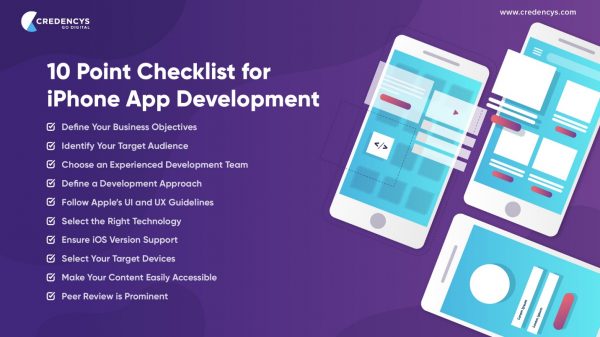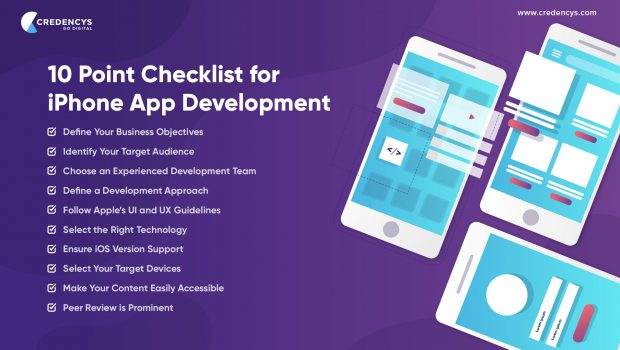iPhone App Development: Checklist You Need to Know for Your Next Project
Mobile applications are changing the world at a fast pace by addressing users’ needs in real-time. According to Statista, the number of smartphone users is forecasted to reach 4.61 billion in 2019 that is around 67% of the global population. The incremental usage of smartphones indicates endless business opportunities by developing Android or/and iOS applications.
Though Android is popular as a user-friendly platform, there is a large user base who loves to use iOS products. Yes, the iPhone user base is expected to surpass 1 billion units by 2019. This number confirms that businesses cannot avoid the essence of iPhone app development. Through this post, I would like to share a checklist for developing an iPhone app for your next project.
10 Point Checklist for iPhone App Development

#1. Define Your Business Objectives
Every app idea serves to a specific purpose. The app either fulfills the consumers’ requirements or addresses your business challenges. Before moving ahead for iPhone app development, analyze the gaps in your industry that your competitors are not able to identify and fill. Also, define your expected outcome from the app.
#2. Identify Your Target Audience
Before creating an app, it is very important to know who is going to use your app. Until you don’t understand your target audience, you cannot get the clarity about which features and functionality you need to incorporate in the app that is expected by end users.
To identify your target audience, conduct a survey with your existing customers and try to explore who would want to use your app and why. Discover the latest industry trends and learn about customers’ demands from a mobile app. Define a list of features & functions expected by users and develop an iPhone app around them. It helps you to address their concerns quickly and ensures the success of your app and business.
#3. Choose an Experienced Development Team
Lots of options available to you when it comes to find a mobile app development team. You can hire freelancers, set up your own team or tie up with a leading mobile app development company.
If you hire freelancers, then you do not have surety about the completion of your project as they work individually rather than collaboratively. In the second option, you can hire your own team but it requires considerable investment as you need to set up an IT infrastructure for your single application.
So the best option is, identify the right iPhone app development company that owns skilled iPhone developers who understand your requirements and deliver an exact solution. They allocate you a dedicated team of technical experts who build a robust app by offering end-to-end iPhone development services at highly cost-effective rates.
#4. Define a Development Approach
The next most important decision you need to make before stepping into the iPhone app development is, whether you want to develop Native app or Hybrid app.
If you are sure about launching your mobile on the App Store only, then go for Native app development. It helps you in developing highly functional applications using many unique features that iOS offers.
Hybrid app development is the best choice if you are planning to expand your apps reach to the other platforms as well. Here you won’t be able to utilize the iOS offering at fullest but it allows you to release your app on multiple platforms.
#5. Follow Apple’s UI and UX Guidelines
With an eye catchy design, you cannot expect users will love to use your app. Design and implement a user-centered UI as it improves user experience with your iOS app. Well, Apple won’t leave you clueless. The company has some formal convention for UI and UX that you have to follow while creating app design. Make sure your entire team reads these protocols and follows them strictly to avoid rework and complete the project on time.
#6. Select the Right Technology
You can either use Swift or Objective C for iPhone app development. Being Apple’s own programming language, Swift streamlines the app development process. It has many unique features that are very useful and speed up the development cycle. More and more iPhone developers are adopting Swift and trying to implement it in app development.
However, the iPhone developers’ community agrees that Objective C is the best choice for highly complex projects. It is simplistic in nature and enables you with extended flexibility that you need for a large scale project.
#7. Ensure iOS Version Support
Every year Apple releases the updated version of iOS. You need to develop an iPhone app that stays compatible with the currently dominating and upcoming iOS versions. To maintain compatibility with the latest versions, you need to keep the app upgraded and updated by leveraging iPhone app maintenance and enhancement services.
#8. Select Your Target Devices
iOS ecosystem has a lesser number of devices to select from compared to Android. Still, you can narrow down your choice by picking one or two highly targeted devices such as iPhones and iPads. Usually, iPhone devices are preferred for consumer-facing applications while enterprise applications are built for iPad devices.
Well, this a standard pattern followed by the companies across the globe but it’s not the rule. You can develop an enterprise app for the iPhone and a consumer-facing app for iPad as per your preferences.
#9. Make Your Content Easily Accessible
If users need to keep changing the direction to view the content in the app, they won’t take much effort to explore the information. So get clarity on how you want to display the content in your app before moving ahead for iPhone app development in order to deliver a better customer experience.
An ideal content presentation for a mobile app should have less scrolling (right to left and top to bottom) with minimum sections, appropriate font size that can be easily readable without zoom-in and zoom-out effect, decent design elements that go with the flow (not too loud and not too dull), etc.
#10. Peer Review is Prominent
Peer review is very important to check the quality of the code. You have a team of iPhone developers who create every single line of code as per their experience and exposure. Due to the different code styling, there are chances of errors in coding during the testing phase.
To avoid such issues and maintain code consistency, you can create a peer review system. Establish a standard code styling and common practices of programming that all team members have to follow while writing the code. So while reviewing the code internally, they ensure to have the desired and well-structured coding in place.
The Final Words
Businesses have to consider a lot of aspects while moving ahead to iPhone app development. Here I have revealed a few most important points that directly impact your customer experience. And we all know bad customer experience means loss of business.
Build user-friendly iPhone applications by considering the above-mentioned checklist. It will help you to simplify your app development process. Considering must have aspects of app development, you can reduce the risk of failure, get an overwhelming response from the users and boost the sales.















